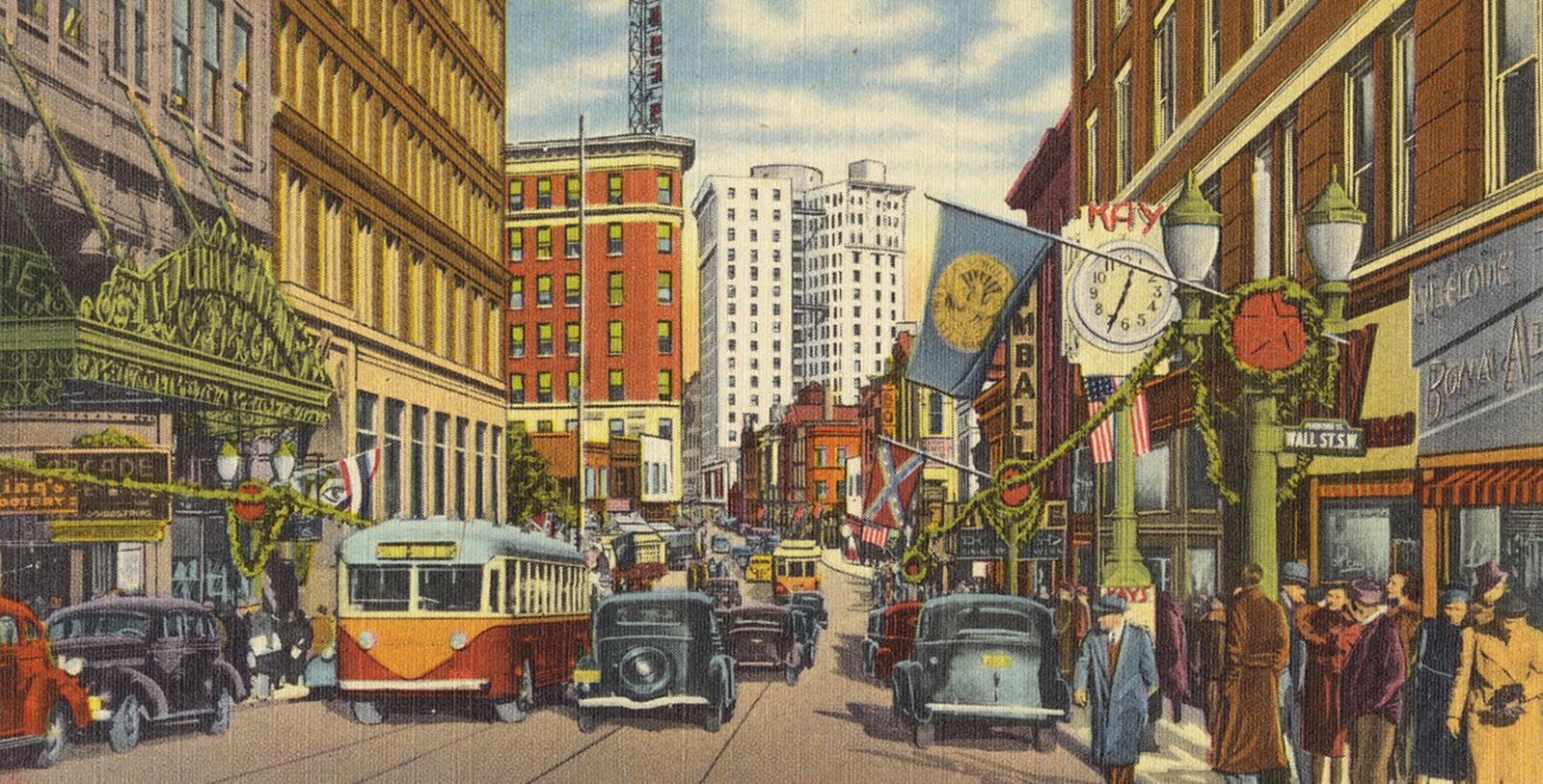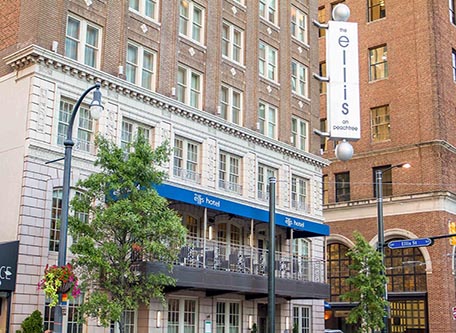Receive for Free - Discover & Explore eNewsletter monthly with advance notice of special offers, packages, and insider savings from 10% - 30% off Best Available Rates at selected hotels.
history
Discover the Ellis Hotel Atlanta, A Tribute Portfolio Hotel by Marriott, which stands in Atlanta today as a brilliant example of historic Classic Revival architecture.
Ellis Hotel Atlanta, A Tribute Portfolio Hotel by Marriott, a member of Historic Hotels of America since 2023, dates back to 1913.
VIEW TIMELINEListed in the U.S. National Register of Historic Places by the U.S. Department of the Interior, the Ellis Hotel Atlanta, A Tribute Portfolio Hotel by Marriott, is a terrific place to stay while exploring Atlanta. Its fantastic facilities, luxurious amenities, and proximity to countless cultural attractions have allured many guests over the years. But the hotel’s history is quite extensive, too, having debuted at a time when Atlanta was rapidly emerging as one of the most prosperous metropolises in the United States. The city itself had specifically become a hub of manufacturing by the early 20th century, with countless industries having appeared all over downtown. The new economic activity galvanized a series of construction projects that quickly added numerous towering skyscrapers to Atlanta’s burgeoning skyline. Among the structures built was the Ellis Hotel Atlanta, A Tribute Portfolio Hotel by Marriott, which originally opened shortly before the outbreak of World War I. It had been the dream of a few aspiring hoteliers who wished to capitalize on the visitor travel that the city’s newfound affluence had spawned. To create the prospective hotel, the entrepreneurs hired the great William Lee Stoddart to spearhead its design. A noted architect, Stoddart had developed an amazing reputation designing numerous upscale hotels across the country, including The Georgian Terrace right up the road. (The Georgian Terrace is a fellow member of Historic Hotels of America.) Impressed, the hoteliers had hoped he could replicate his earlier successes.
Stoddard proceeded to design a gorgeous 15-story structure with a skeleton of steel and reinforced concrete that he then encased within a layer of tile and brick veneer. The materials blended well together, especially as Stoddart crafted them to uniformly display a variety of spectacular Neoclassical motifs. Perhaps his most stunning designs involved carving classically inspired ornamentation around the white terra cotta moldings on the top floors. But Stoddard’s tireless efforts to turn the hotel into a visual masterpiece did not end with the exterior. Indeed, he applied many breathtaking architectural details throughout the interior as well, particularly in the hotel’s spacious main lobby and several dozen guestrooms. When work on the new hotel finally concluded in 1913, it immediately became an incredibly popular social gathering spot in the heart of Atlanta. In fact, the business eventually helped form an enclave of exclusive hotels along Peachtree Street that were integral to cultivating the city’s vibrant nightlife during the 1920s. More recently in 2006, the Ellis Hotel Atlanta, A Tribute Portfolio Hotel, underwent an extensive, year-long renovation that saw it reborn as a stunning boutique destination. The restoration brilliantly updated the floorplan to reflect a more contemporary atmosphere, while also preserving its rich architectural heritage. A member of Historic Hotels of America since 2023, the Ellis Hotel Atlanta, A Tribute Portfolio Hotel by Marriott, continues to shine as one of Atlanta’s finest holiday destinations.
-
About the Location +
Atlanta originally came into existence in the late 1830s, when the Western and Atlantic Railroad selected the site of present-day Atlanta as the location for a train depot. Commissioned by the Georgia General Assembly, the railroad itself was intended to link the seaside city of Savannah further inland to the commercially important settlement of Chattanooga, Tennessee. As such, the railroad hoped the train depot would provide specific logistical support for all of its locomotives that needed to traverse the rugged Appalachian Mountains first. A small community soon formed around the nascent train depot, which was originally known as both “Terminus” and “Marthasville” before finally becoming “Atlanta” during the 1840s. Much to the pleasure of the Georgia General Assembly, traffic along the Western and Atlantic Railroad grew rapidly over the next two decades. The activity subsequently inspired several private companies to link their own routes through the fledgling city, thus attracting even more industries to Atlanta. By the mid-19th century, the city had evolved into one of the most economically vibrant communities in the entire nation. But Atlanta’s value as a transportation hub and manufacturing center made it a target for the Union Army throughout the American Civil War. In 1864, Major General William Tecumseh Sherman specifically achieved the elusive goal of capturing Atlanta after a four-month-long siege known as the “Battle of Atlanta.” Confederate and Union forces desolated the city during the fight, as they both hoped to deprive the other of the area’s useful military assets. Despite its dilapidated state following the battle, Sherman used Atlanta as his main supply base amid his “March to the Sea.” However, its capitulation was also a significant boost to Northern morale, even aiding in President Abraham Lincoln’s reelection later that autumn.
When the American Civil War finally ended, Atlanta was swiftly rebuilt. The community gained political importance though, as the state legislature had decided to meet in the area to better coordinate the postwar rebuilding efforts across Georgia. Atlanta’s railroad network made communicating with those disparate communities incredibly easy, too, which eventually influenced the state administration to permanently relocate Georgia’s capital to Atlanta in 1868. Atlanta’s own recovery saw many new businesses open downtown, the most notable of which was the now-famous Coca-Cola Company. Founded by Asa Griggs Candler in 1892, the Atlanta-based business had quickly emerged as a multimillion-dollar corporation in a handful of years from the distribution of its iconic software drink. As such, economic prosperity had fully returned to the city at the end of the 1800s. But local race relations were a constant point of contention, which ultimately made Atlanta a hotbed for the Civil Rights Movement several decades later in the 20th century. Led by Atlanta-native Martin Luther King, Jr., the city’s civil-rights activists began organizing massive protests that struck at racial inequality both locally and nationally throughout the 1950s and 1960s. King and his fellow members in the Southern Christian Leadership Conference soon emerged as some of the most iconic spokespeople for the whole movement. In recognition of his legacy, King’s Ebenezer Baptist Church and his adjacent gravesite currently serve as the centerpiece for the Martin Luther King, Jr. National Historic Site. Atlanta today is now one of the most historic destinations in the whole nation. From its fascinating Civil War-era history to its connections with Martin Luther King Jr., few places can claim the heritage that Atlanta possesses.
-
About the Architecture +
Ellis Hotel Atlanta, A Tribute Portfolio Hotel by Marriott, stands today as a brilliant example of American Classic Revival architecture. Also known as “Neoclassical,” Classic Revival design aesthetics are among the most common architectural forms seen throughout the United States. This wonderful architectural style first became popularized at the World’s Columbian Exposition, which was held in Chicago in 1893. Many of the exhibits displayed architectural motifs from ancient societies like Rome and Greece. As with the equally popular Colonial Revival style of the same period, Classical Revival architect found an audience for its more formal nature. It specifically relied on stylistic design elements that incorporated such structural components like the symmetrical placement of doors and windows, as well as front porches crowned with classical pediments. Architects would also often install rounded front porticos that possessed balustraded flat roofs. Pilasters and other sculptured ornamentations proliferated across the façade of the building, as well. Perhaps the most striking feature of buildings designed with Classical Revival-style architecture were massive columns that displayed some combination of Corinthian, Doric, or Ionic capitals. With its Greco-Roman temple-like form, Classical Revival-style architecture was considered best for municipal buildings, such as courthouses, libraries, and schools. But the form found its way into more commercial uses over time, like banks, department stores, and of course, hotels. The celebrated architectural firm McKim, Meade and White produced some of the finest buildings that showcased Classical Revival architecture, with a majority their work debuting during the early 20th century. Examples of their portfolio can be found throughout most of American’s major cities, including Philadelphia and New York City. They were later joined by many other prominent architects, including the creator of the Ellis Hotel Atlanta, A Tribute Portfolio Hotel by Marriott—William Lee Stoddard.































